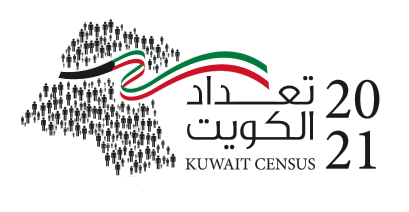
Registration Census of Kuwait 2021
 The Ministry of State for Communications and Information Technology has implemented the Registration Census Project of Kuwait 2021 through cooperation with Central Statistical Bureau and the Public Authority for Civil Information by investing the resources, national cadres, support expertise and cooperation of the data providers that have yielded the desired outcomes. The General Census is the main pillar of the official statistics system in Kuwait and is one of the projects implemented to provide quality and coordinated population statistics through the harmonization of administrative records of governmental and non-governmental entities in line with the census's requirements to support the State in using its record sources and conducting the first registration census of Kuwait 2021.
The Ministry of State for Communications and Information Technology has implemented the Registration Census Project of Kuwait 2021 through cooperation with Central Statistical Bureau and the Public Authority for Civil Information by investing the resources, national cadres, support expertise and cooperation of the data providers that have yielded the desired outcomes. The General Census is the main pillar of the official statistics system in Kuwait and is one of the projects implemented to provide quality and coordinated population statistics through the harmonization of administrative records of governmental and non-governmental entities in line with the census's requirements to support the State in using its record sources and conducting the first registration census of Kuwait 2021.
This census is in line with international statistical standards that urge countries to use administrative records in statistical processes and to create a sophisticated statistical system that contributes to the provision of comprehensive statistical data on the population's distribution and its basic, demographic, social and economic characteristics. As well as providing statistical data on buildings and population conditions, data on economic establishments and activities carried out and the number of employees and their geographical distribution to be used for planning and economic and social development in order to serve the implementation of development plans and achieve Kuwait Vision 2035 "New Kuwait".
The registration Census 2021 for Kuwait relies on integrated databases of relevant administrative records to ensure their consistency and integration and to provide the necessary information for public policy makers and decision makers in a digital format that represents the basis for evidence-based decision-making for the government sector, the private sector, academics, researchers and the public, and to meet the demand for quality and continuity data locally and regionally. and internationally.
It is noteworthy that the first census was implemented in the State of Kuwait in 1957, then the census in 1961 under the supervision of the Department of Social Affairs of the Ministry of Social Affairs and Labor, then the Statistics and Census Law No. Implementation of eight censuses from 1965 to 2011 by adopting the methodology of comprehensive enumeration of buildings.
Registered Census Methodology
The registry census methodology differs from the traditional field census methodology in that it relies on administrative records located in the country's authorities, rather than data collected in the field through surveys. The registration census methodology faces a challenge about how to harmonize the record data with the census project data basket because this data is extracted from records and databases established for purely administrative purposes according to the nature of each of the exporting agencies, which are often not compatible with the requirements of the census.
The census data was selected from the recommended data basket guide for the unified population and housing registration census 2020 for the countries of the Cooperation Council for the Arab States of the Gulf issued by the Gulf Statistics Center for the year 2019, and from the data basket of the general census of the State of Kuwait 2011.
The Main objectives of the registration census project for the State of Kuwait 2021
The objectives of the census project are determined in the light of local requirements, and the basic data needed by planners and policy makers, as well as in the light of regional and international recommendations. Perhaps one of the most important objectives of the census project for the State of Kuwait 2021 is the following:
A. Studying the changes that occurred in the geographical distribution of the population and the trends of this change since 2011.
B. Studying the growth of the Kuwaiti and non-Kuwaiti population separately, and determining the directions of this growth.
C. Studying the age and gender structure of the population (Kuwaiti and non-Kuwaiti).
D. Studying the composition of the population according to some of their demographic, social and economic characteristics.
E. Identify patterns of family structure in Kuwaiti society.
F. A study of the labor force in Kuwait (Kuwaiti and non-Kuwaiti) with the classification of those outside the labor force.
G. Studying the vocational composition of the Kuwaiti and non-Kuwaiti workforce, which helps to identify the extent to which the State of Kuwait has kept pace with modern technological developments.
H. Studying the distributions of the Kuwaiti and non-Kuwaiti labor force on various aspects of economic activities.
I. Studying the distribution of the Kuwaiti and non-Kuwaiti workforce among the various sectors (governmental, joint, private, cooperative, and family).
J. Provide an integrated database among the relevant administrative records.
K. Linking data to a reference database to ensure its consistency and integrity.
L. Linking with data exporters.
M. Supporting development efforts and providing the necessary information to public policy makers and decision makers.
N. Meet the demand for data locally, regionally and internationally, especially with regard to organizations responsible for international indicators and reports.
O. Providing periodic reports (monthly-quarterly-annual).